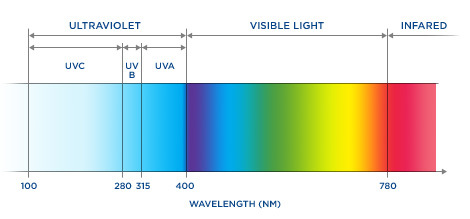Ultraviolet (UV) light is part of the electromagnetic spectrum between visible light and
X-rays.

The UV spectrum is divided in 4 ranges:
UVA
This range extends from wavelengths between 315 – 400 nm (nanometer). Light in this range is absorbed by the skin and leads largely to “sun tanning”.
Application for these wavelengths:
- attraction of insects
- katalysation of titaniumdioxide (TiO2)
- breakdown of trichloramine, part of ‘chlorine smell’ in swimming pools
UVB
This range extends from wavelengths between 280 – 315 nm. Light in this range is also absorbed by the skin but leads largely to “sun burning”.
Applications for these wavelengths:
- inactivation of microorganism, as DNA absorbs wavelengths below 315 nm
- breakdown of dichloramine, part of ‘chlorine smell’ in swimming pools
- breakdown of ozone
UVC
This range extends from wavelengths between 200 – 280 nm. This range is absorbed by DNA and RNA (genetic molecules) in micro-organisms and leads to their inactivation (‘killing’) by inhibiting their ability to replicate.
Applications for these wavelengths:
- inactivation of microorganisms, as DNA/RNA absorbs at maximum wavelength of 260-270 nm
- breakdown of ozone, hypochlorite, hydrogenperoxide
- formation of hydroxylradicals
Vacuum UV
This range extends wavelengths from 100 – 200 nm. It is called “vacuum UV” since UV light in this range is strongly absorbed by water or oxygen in air and can thus only exist in vacuum.
Applications for these wavelengths:
- production of ozone, active oxygen
- dissociation of chemical bands
Contact the ‘experts in ultraviolet light’ to fully optimise your new or existing water treatment system with bestUV technology.

